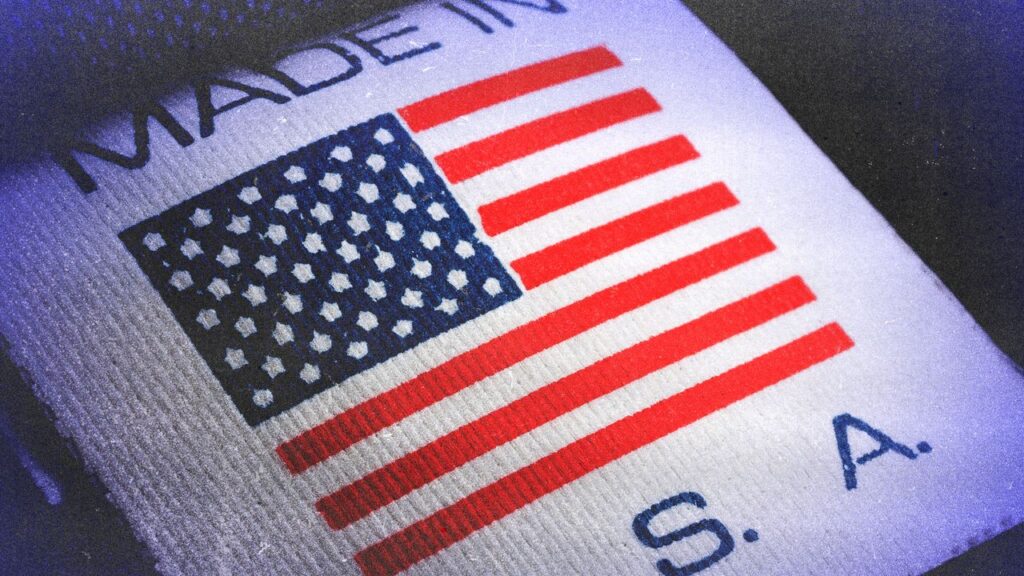At a glance, the American Trench Retro Stripe looks exactly like what it is: the kind of calf-hugging cotton sport sock that’s been a ubiquitous part of the American wardrobe since Kareem Abdul-Jabbar made them cool in the ’70s. An American Trench sock, however, is fundamentally different from the kind you’d buy in a multipack on Prime Day (and not just because of its jazzy color palette). That’s because the Retro Stripe, unlike most athletic socks bought in the United States, can legally be labeled “Made in USA.” Earning the right to put that label on a piece of clothing, however, isn’t just a matter of choosing to make it in a factory in Maine or New Jersey instead of China or Honduras. And thanks to the Trump tariffs, a Federal Trade Commission stacked with MAGA Republicans, and a growing demand for American-made products of all kinds, the distinction has never been more political.
According to the FTC, the agency responsible for consumer protection, “a product may be advertised as “Made in the USA” if “all or virtually all” of the labor and materials in the product are domestic.” What constitutes “virtually all” is somewhat open to interpretation and varies state-to-state (in California, for example, it’s up to 10 percent of the final wholesale value), but it essentially means that in order to stick a Made in USA label on a pair of socks, they need to be manufactured in the US from American-made materials. “The cotton is grown in North and South Carolina, it gets ginned locally, and then it gets sent to a yarn spinner,” explains Jacob Hurwitz, the founder of Philadelphia-based American Trench, tracing the journey of a Retro Stripe from the cotton field to your mailbox. “Then the yarn is sent to the sock factory that knits the socks and dyes them. The entire product from start to finish is made in the USA.”
While the United States has a relatively solid infrastructure for turning domestically grown cotton into socks, that’s not the case with a lot of other things in your wardrobe. Sixty years ago, most of the clothing Americans bought was made in America, but thanks to free trade deals, globalization, and apparel brands’ perennial pursuit of ever-lower labor costs, most of it is now imported. The result is a fashion landscape where Americans buy far more clothing than they ever had before, pay much less for it, and throw it in the garbage by the truckload. It also means that the once-thriving American textile industry is now a shadow of its former self. “The real issue for brands that want to create an entirely made in USA product, from yarn to end-state manufacturing, is that the supply chain has been hollowed out,” explains Hurwitz. “There are just many things that you can’t get here.” Further complicating matters, many of the suppliers that do exist are scaled to cater to much larger buyers than American Trench, making it difficult for indie brands to source the materials they need in the quantities they require.
For most people who care about such things, whether or not a piece of clothing that was cut and sewn in an American factory probably matters more than whether the fabric was also made here (except if that fabric is selvedge denim). For a brand looking to tout its American-made credentials, however, labeling a flannel shirt “Made in USA” when in fact it’s cut from Italian-made fabric is an increasingly risky proposition. Last year, the FTC sent $140,000 worth of refunds to customers of several New England-based brands that had falsely claimed that their products were made in America. Earlier this month, the FTC sent warning letters to Amazon and Walmart regarding third-party sellers making false Made in America claims on their marketplaces.
Companies making clothes in the USA from imported cloth (say, an NYC tailor using Italian fabric to make a suit) can stay within the letter of the law by “qualifying” their Made in the USA claim, i.e., disclosing that the suit is made in the US with foreign materials, but not everyone does. For one thing, “Made in the USA From Imported Materials” doesn’t have quite the same ring to it, and for another, it hasn’t always been a big deal. “Most people completely ignore the law because, depending on which administration is in office, it may not be a priority. It’s a very political statute,” explains Shawn Collins, a lawyer based in Newport Beach, California, specializing in consumer litigation and enforcement. “Now we have a president who’s using the office of the presidency to effectively encourage—and sometimes bully—Americans into buying American-made products. The FTC has been given a mandate to push his America-first agenda, and they’re going to use this statute that’s been there for a long time but hasn’t really been utilized very much.”
While most reputable apparel brands probably wouldn’t risk fraudulently labelling clothes produced in Vietnam or Honduras as Made in USA, the somewhat subjective nature of the law, combined with previously lax enforcement, could give the FTC plenty of potential targets in the coming years. “People tend to focus on the label because that’s typically where you see the Made in the USA claim, but most people do their shopping online,” says Collins. “So, where is that consumer most likely to engage with your label or product? If your digital ads are not disclosing a truthful and accurate Made in the USA label, you’re technically in violation of the law.”
The FTC’s roster of recent lawsuits and warnings might motivate some bad actors to change their labeling or seek legitimate US suppliers, but given the fractured supply chains and slimmer margins inherent in making clothes domestically, it’s easier said than done. For American Trench and many other small brands, however, staying on the right side of the FTC’s complex labeling regulations is just one of the many hurdles involved in earning the right to label something Made in USA.


